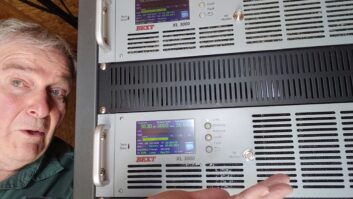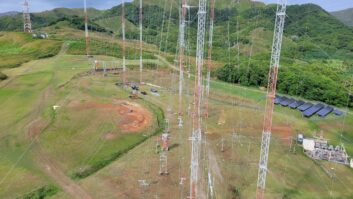To say the weather throughout the country has been bizarre recently is an understatement. From flooding to fire and hurricane-force winds, it seems broadcast engineers are dealing with new perils every day.
Other than developing a “doomsday” site for emergency backup, there’s not much an engineer can do to fight many of these natural perils – or is there?
When was the last time your tower was inspected? By inspected, I mean a rigger checking all the lines as they climb to the top, and making immediate repairs – not postponing the work until next year. If you own your tower and lease space to others, what safeguards have you put in place to ensure that not just any jack-leg climbs it?
The questions are pertinent. For example, a major-market tower recently was fitted with coax lines for a new tenant. No one seems to know who did the work; the lines just appeared one day. To save money, the lines were lashed to the tower leg with the steel wire used to tie pieces of rebar together.
Then the winds came.
Snap!
(click thumbnail)Fig. 1: The 7/8-inch lines running up the left side were lashed to the leg with steel wire. Winds tore the cables from their mounts.
(click thumbnail)Fig. 2: The replacement dish is hoisted into place.
If you ever wonder why butterfly or snap-in hangers are used, Fig. 1 will help justify the cost. Look at the three 7/8-inch lines running up the left side of the tower. These are the ones that were lashed to the leg with the steel wire.
Strong winds tore the cables from their mounts, and they were flapping in the breeze. Notice the STL dish being hoisted. The cables swung so far that they damaged the feed horn of the STL dish, snapping the dish off its mounts.
Fig. 2 shows the replacement dish being hoisted into place. (Fig 2 – DSC-0499). This photo also gives you a better picture of the haphazard way these lines were installed.
Not only were the lines swaying in the breeze; so was the tower structure. Improper support takes its toll. Fig. 3 shows those same three lines, at ground level, bent, as the wind moved both the tower and the unsupported line.
What’s interesting in this photo is that the damage, especially to the line to the right, was caused by the line being pulled taut and rubbing against the white insulator that’s anchored to the tower leg, about a foot and a half above the lines. This movement occurred as the wind used the lines as sails, once they broke free from the rebar fastening wire.
(click thumbnail)Fig. 3: Improper support takes its toll.
(click thumbnail)Fig. 4: The lines enter the building. The one in the center has been pulled out nearly 5 inches.
Fig. 4 shows where these lines enter the communications building. The line in the center of the photo has been pulled out nearly 5 inches (note the sealant on the line) by all this action.
Although I couldn’t see inside, I imagined this transmitter rack sitting lopsided on two of four feet.
Back it up
So what do we conclude from this catastrophe? First, think backup systems. Even if it’s a Comrex HotLine that can be pressed into “STL” use, have a plan for this kind of problem.
With decent pricing of ISDN service, a growing number of station engineers have installed ISDN lines to transmitter sites. Better yet, consider a frequency agile exciter and a broadband antenna bay that can give you some kind of backup until your full-power facility can be repaired.
Do you have a spare STL dish? If not, consider investing in a spare feed horn. Don’t forget the pigtails, either. Both can go bad and spoil your day.
There’s a limit to what you can do to, of course. But if you’ve set backup systems in place, test them. As too many engineers found out this summer, a generator that won’t start is no kind of insurance.
As for the tower, consider inserting a clause in your lease that prohibits just any tower crew from installing or working on your tower for your tenants. Stipulate that you must be notified in advance of any work to be done and who will be doing it.
Get copies of the tower rigging company’s insurance certification and request these directly from the insurance company, to make sure the policy is current. If $20 bills can be printed on laser printers, so can insurance certifications. You just can’t be too careful these days.
Consider arming the tower or gate perimeter with a motion detector, tied to the remote control, to warn you of unauthorized entry. And in the case of the rebar tie-wire, the lease should state that any installations use the appropriate manufacturer’s hardware, preferably approved by you prior to the installation.
You can’t be prepared for every disaster, but a little forethought can reduce the impact.
Submissions for this column are encouraged and qualify for SBE recertification credit.
















